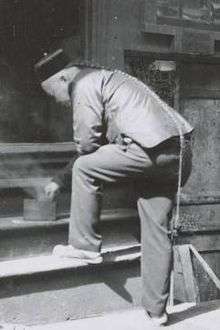Pigtail Ordinance

The Pigtail Ordinance was an 1873 law intended to force prisoners in San Francisco, California to have their hair cut within an inch of the scalp. It affected Han Chinese prisoners in particular, as it meant they would have their queue, a waist-long, braided pigtail, cut off. The proposal passed by a narrow margin through the San Francisco Board of Supervisors in 1873 but was vetoed by the mayor. An identical version of the law, enacted in 1876, was struck down as unconstitutional in 1879.
Origins
The Pigtail Ordinance was proposed as a solution to the overcrowding of jails due to the 1870 Sanitary Ordinance, which was originally meant to prevent unsafe tenement conditions in San Francisco. When in violation of the Sanitary Ordinance, one could either pay a fine or serve a week or more in jail; for thousands of impoverished Chinese immigrants, free room and board was a welcome punishment. Ostensibly to prevent outbreaks of lice and fleas, the Supervisors began requiring that all prisoners' heads be shaved.[1] Many equal rights advocates, however, claimed the Supervisors' true intent was to stem the tide of willing Chinese convicts.[2]
Since the beginning of the Qing Dynasty in 1644, Han men in China had been required to wear the queue as a sign of submission to the ruling Manchu people. The penalty for refusal was death.[3] The majority of Chinese immigrants who moved to America only intended to stay in the United States long enough to make a living and return to China, so they needed to keep their queues to ensure their ability to return.[4] In light of this, the idea behind the institution of the Pigtail Ordinance was that Chinese immigrants would be less likely to ignore the Sanitary Ordinance if such a heavy penalty was the result.[2]
Veto and passage
After passage through the Board of Supervisors, the order was immediately vetoed by mayor William Alvord. In his veto, the mayor stated that "this order, though general in its terms, in substance and effect, is a special and degrading punishment inflicted upon the Chinese residents for slight offenses and solely by reason of their alienage and race."[5] Instead, enforcement of the anti-tenement law was relaxed.
On April 3, 1876 the state of California passed their own law to Los Angeles's Sanitary Ordinance. The city no longer had the power to ignore the enforcement of the law, so the board made a second proposal of the Pigtail Ordinance. This time the law passed with a vote of 10-2, and was approved by mayor Andrew Jackson Bryant.
Lawsuit
As a result of the new law, a Chinese immigrant named Ah Kow was arrested for living space violations and had his queue removed at the jail. He sued the sheriff for damages, claiming that the Pigtail Ordinance caused him irreparable harm. On June 14, 1879 United States Supreme Court Justice Stephen Johnson Field, sitting in the local federal court—despite much criticism from the general public—found in favor of the plaintiff; his decision held that it was not within the powers of the Board of Supervisors to set such a discriminatory law and that the ordinance was, in fact, unconstitutional. In particular, he cited the Fourteenth Amendment to the United States Constitution which guarantees equal protection under the law to all persons within its jurisdiction. See Ho Ah Kow v. Nunan, 12 Fed. Cas. 252 (1879).[6]
See also
References
- ↑ Stewart, Fred M. (1989). The Glitter and the Gold. New American Library. p. 266.
- 1 2 Healy, Patrick Joseph (1905). A Statement for Non-exclusion. pp. 246,250–251.
- ↑ Hiltebeitel, Alf, ed. (1998). Hair: Its Power and Meaning in Asian Cultures. State University of New York Press. p. 128.
- ↑ Jones, Claire (1972). The Chinese in America. Minneapolis, Minnesota: Lerner. p. 44.
- ↑ Gibson, Otis (1877). The Chinese in America. Hitchcock and Walden. p. 283.
- ↑ Black, Chauncey F. (1895). Some Account of the Work of Stephen J. Field. pp. 397–405.